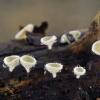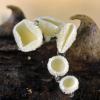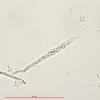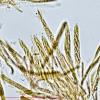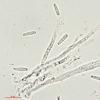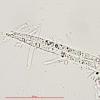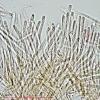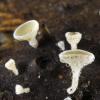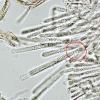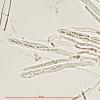
18-12-2025 21:17
Pol DebaenstThe identification took me to Byssonectria deformi

15-12-2025 07:09
 Danny Newman
Danny Newman
indet. Rutstroemiaceae sp. on unk. fallen leavesMc

19-12-2025 10:10
Patrice TANCHAUDBonjour, r챕colte r챕alis챕e en milieu dunaire, a

18-12-2025 17:23
 Bruno Cou챕
Bruno Cou챕
Bonjour,je serais heureux d'avoir votre avis sur c

18-12-2025 18:07
Margot en Geert VullingsThese plumes were found on rotten wood.They strong

17-12-2025 18:35
 Michel Hairaud
Michel Hairaud
Bonjour 횪 tous/Hi to everyone혻I am passing along

15-12-2025 15:48
 Danny Newman
Danny Newman
Melanospora cf. lagenaria on old, rotting, fallen

15-12-2025 15:54
 Johan Boonefaes
Johan Boonefaes
Unknown anamorph found on the ground in coastal sa

15-12-2025 21:11
 Hardware Tony
Hardware Tony
Small clavate hairs, negative croziers and IKI bb
Lachnum on Rubus
Miguel 횁ngel Ribes,
26-06-2009 18:03
 Hello
HelloI have a small Lachnum, 2-3 mm diameter, with stem, pale-yellow to beige hymenium, white hairs, on Rubus, in a laurisilva forest (Tenerife, Canary Islands). Macroscopically it seems L. salicariae. With Zotto key I arrive to L. cf. crataegi (= virgineorubescens) if Rubus is considered as "wood" or to L. carneolum if Rubus is considered as "grass" :o/
This are the measurements in water, at 1000x, with fresh material::
Spores: 6.5 [8 ; 8.5] 10 x 1.2 [1.7 ; 1.8] 2.3; Q = 3.4 [4.6 ; 5] 6.2 ; N = 44 ; C = 95%; Me = 8.24 x 1.75 ; Qe = 4.8
Asci: 52.9 [59.8 ; 63.6] 70.5 x 3 [3.9 ; 4.4] 5.3; N = 22 ; C = 95%; Me = 61.68 x 4.18
Paraphysis: 72.2 [89.9 ; 105.1] 122.8 x 3.3 [4 ; 4.6] 5.4; N = 11 ; C = 95%; Me = 97.49 x 4.33
Hairs: 56.6 [67.6 ; 73.5] 84.5 x 2.6 [3.2 ; 3.5] 4; N = 22 ; C = 95%; Me = 70.55 x 3.34
Thank you in advance
Miguel 횁ngel Ribes,
26-06-2009 18:08
Miguel 횁ngel Ribes,
26-06-2009 18:11
Hans-Otto Baral,
26-06-2009 23:43

Re:Lachnum on Rubus
Dear Miguel
could be something like L. pudibundum. Does your fungus have croziers? It seems so, judgung from the ascus base. L. pudibundum has simple septa but I remember to have seen sometimes a close taxon with croziers.
The paraphyses obviously protrude strongly. In the living state I think that also the hairs contained abundant VBs in their lower part. Do the apothecia show some change to red-brown?
Your ascus measurements refer to dead asci, as I can find out with your scale.
Zotto
could be something like L. pudibundum. Does your fungus have croziers? It seems so, judgung from the ascus base. L. pudibundum has simple septa but I remember to have seen sometimes a close taxon with croziers.
The paraphyses obviously protrude strongly. In the living state I think that also the hairs contained abundant VBs in their lower part. Do the apothecia show some change to red-brown?
Your ascus measurements refer to dead asci, as I can find out with your scale.
Zotto
Miguel 횁ngel Ribes,
27-06-2009 01:04

Re:Lachnum on Rubus
Dear Zotto
Yes, it has croziers (I wrote it in the third photo).
Yes, the apothecia shows some change to red-brown, see this photo, please. But I haven't see the lower part of the hairs finding VBs.
No, ascus measurements are made with fresh and good conditions material, living yet on the Rubus. In the third photo the scale line is 50 microns and the asci are little longer (60-70 aprox.). The fourth photo is made with IKI and perhaps the asci are shorter than 50 microns, but all my measurements are made in water, not in IKI. And finally the fifth photo has a 10 microns scale line, similar to the spore length.
Thank you
Yes, it has croziers (I wrote it in the third photo).
Yes, the apothecia shows some change to red-brown, see this photo, please. But I haven't see the lower part of the hairs finding VBs.
No, ascus measurements are made with fresh and good conditions material, living yet on the Rubus. In the third photo the scale line is 50 microns and the asci are little longer (60-70 aprox.). The fourth photo is made with IKI and perhaps the asci are shorter than 50 microns, but all my measurements are made in water, not in IKI. And finally the fifth photo has a 10 microns scale line, similar to the spore length.
Thank you
Hans-Otto Baral,
27-06-2009 11:42

Re:Lachnum on Rubus
Hi Miguel
on your hair photo it is visibel that the lower part of the hairs show some shade of ochraceous, and this colour is certainly due to oxidation of VBs. So I strongly presume that the living hairs were guttulate in their lower part. The cream disc on your new photo also obviously results in such oxidation process of VBs.
Concering ascus size, your images show only dead asci. I therefore measured these asci and found that they fit to your data, concluding that they were gained from the dead shunken state. For example, from your photo with two asci I evaluate the width as ca. 4.5 쨉m, so your mean values of 3.9-4.4 쨉m obviously refer to dead asci (in water). Living asci are here probably 4.5-5.5 쨉m wide in my experience. This should always be taken into account when comparing ascus size between collections and between different taxa.
Zotto
on your hair photo it is visibel that the lower part of the hairs show some shade of ochraceous, and this colour is certainly due to oxidation of VBs. So I strongly presume that the living hairs were guttulate in their lower part. The cream disc on your new photo also obviously results in such oxidation process of VBs.
Concering ascus size, your images show only dead asci. I therefore measured these asci and found that they fit to your data, concluding that they were gained from the dead shunken state. For example, from your photo with two asci I evaluate the width as ca. 4.5 쨉m, so your mean values of 3.9-4.4 쨉m obviously refer to dead asci (in water). Living asci are here probably 4.5-5.5 쨉m wide in my experience. This should always be taken into account when comparing ascus size between collections and between different taxa.
Zotto
Miguel 횁ngel Ribes,
29-06-2009 00:08
Miguel 횁ngel Ribes,
29-06-2009 00:32

Re:Lachnum on Rubus
Hi again Zotto
Concerning to the living state, I have this asci photo, dead too, I suppose. How is possible that the apos were still living and growing on the Rubus in my refrigerator, and the asci were dead in water? I am using "Agua Est챕ril para Inyectables Braun" (Injectable sterile water Braun) + 4% Glycerin to avoid the quick dehyidration and to reduce the spores movement. Is this the problem?
Thanks you very much
Concerning to the living state, I have this asci photo, dead too, I suppose. How is possible that the apos were still living and growing on the Rubus in my refrigerator, and the asci were dead in water? I am using "Agua Est챕ril para Inyectables Braun" (Injectable sterile water Braun) + 4% Glycerin to avoid the quick dehyidration and to reduce the spores movement. Is this the problem?
Thanks you very much
Ra첬l Tena Lahoz,
29-06-2009 10:10

Re:Lachnum on Rubus
Hola Miguel 횁ngel, tambi챕n ocurre a veces que al chafar la preparaci처n los elementos mueren. Hay que intentar chafar lo menos posible, aunque esto suponga que todo se mueva mucho m찼s. En cuanto al medio no te puedo ayudar, igual Zotto te sabe contestar. Yo utlizo agua destilada o agua del grifo y con un poco de pr찼ctica se distinguen bien las que est찼n vivas y las que est찼n muertas. Muchos elementos mueren al desecarse un poco mientras se hace la preparci처n, otros al cortar, y otros al chafar.
Un abrazo,
Ra첬l.
Un abrazo,
Ra첬l.
Miguel 횁ngel Ribes,
29-06-2009 13:26

Re:Lachnum on Rubus
Hola Ra첬l
Despu챕s de escribir el mensaje estuve viendo nuevamente los archivos relacionados con la taxonom챠a vital del DVD de Zotto, a ver si aprendo algo m찼s, sobre todo a distinguir las estructuras vivas de las muertas. Y efectivamente indica muy claramente que material fresco no es sin처nimo de material vivo y que uno de los factores es la presi처n al preparar la muestra.
Muchas gracias,
Despu챕s de escribir el mensaje estuve viendo nuevamente los archivos relacionados con la taxonom챠a vital del DVD de Zotto, a ver si aprendo algo m찼s, sobre todo a distinguir las estructuras vivas de las muertas. Y efectivamente indica muy claramente que material fresco no es sin처nimo de material vivo y que uno de los factores es la presi처n al preparar la muestra.
Muchas gracias,
Hans-Otto Baral,
29-06-2009 22:55

Re:Lachnum on Rubus
Yes, these are clearly VBs.
I imagine that the glycerin is the problem. Simply avoid such ingredients and use mere tap water or rain water. Also do not press too much on the cover slip.
Zotto
I imagine that the glycerin is the problem. Simply avoid such ingredients and use mere tap water or rain water. Also do not press too much on the cover slip.
Zotto
Miguel 횁ngel Ribes,
30-06-2009 00:45

Re:Lachnum on Rubus
Thank you again Zotto, I will use tap water in advance.
So, which is the nearest species are you thinking to this record? In Subkey 3 (- + +) I arrive to L. cf crataegi or L. carneolum / L. tenuipilosum.
Good night
So, which is the nearest species are you thinking to this record? In Subkey 3 (- + +) I arrive to L. cf crataegi or L. carneolum / L. tenuipilosum.
Good night
Hans-Otto Baral,
30-06-2009 08:23

Re:Lachnum on Rubus
I am now quite sure that your taxon can be named L. fasciculare, judging from my reexamination of the lectotype (see DVD HB 7184).
Zotto
Zotto
Miguel 횁ngel Ribes,
30-06-2009 17:07

Re:Lachnum on Rubus
Thank you Zotto, I am very grateful to you.

